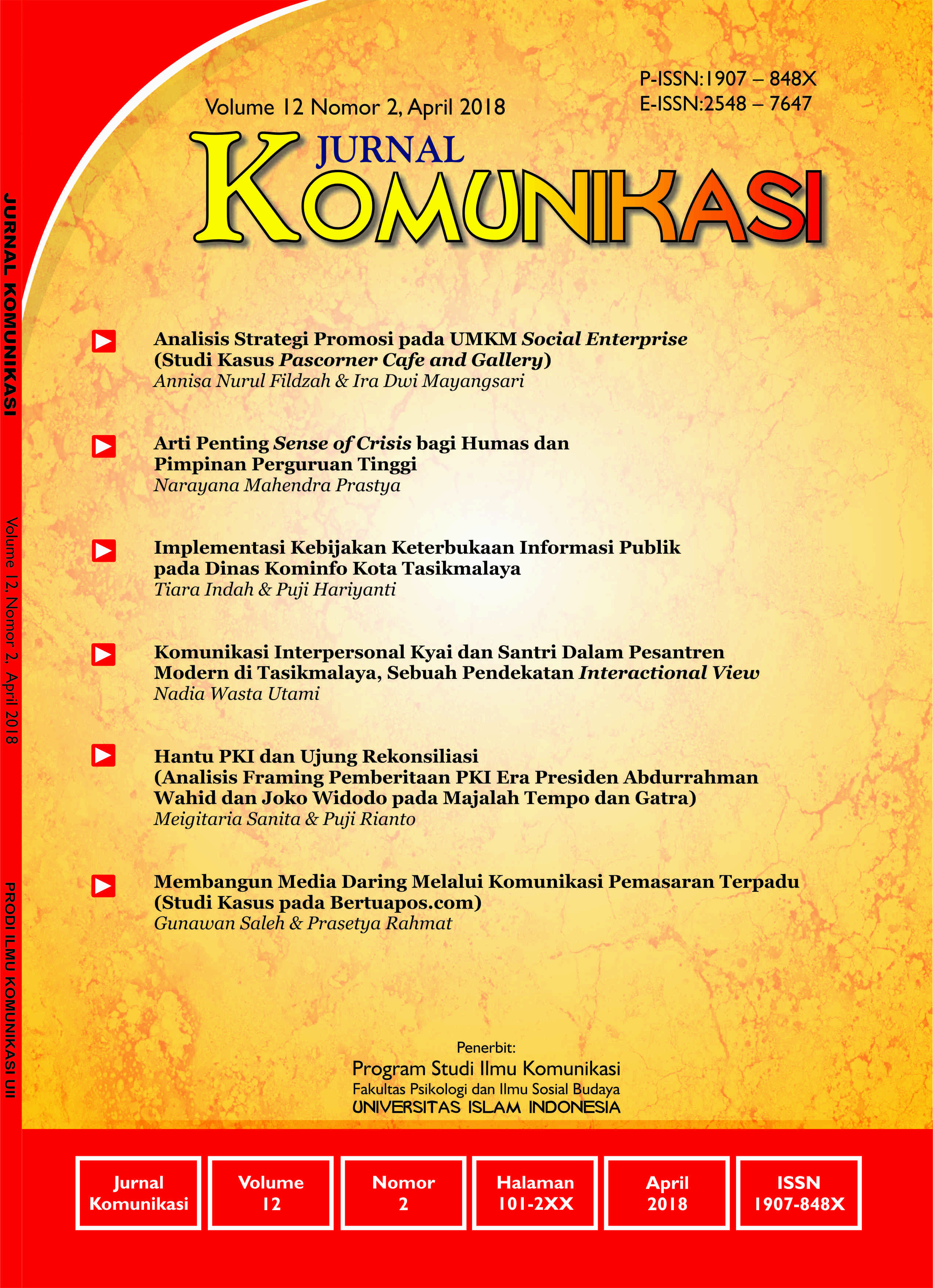Main Article Content
Abstract
The issue of PKI and the efforts of reconciliation rose by mass media every year become a controversial issue. This issue increased especially in the era of President Abdurrahman Wahid (Gus Dur) and Joko Widodo. This research explains how Tempo and Gatra constructed PKI and framed the reconciliation issues in this two presidency era. This research uses Robert Entman’s model of framing analysis. The research found that articles in Tempo tend to place the PKI as a victim, support reconciliation efforts, and the importance of historical alignment. According to Tempo, the New Order had a major role in "shaking up" the PKI. Gatra, on the other hand, tends to be balanced and views the history of the PKI as historical traumatic for Indonesian peoples. Gatra supports reconciliation done naturally, and that history should be reexamined. The difference between the two magazines was influenced by ideology, organizational routine, and extra media power.
Keywords: PKI, Framing Analysis, Construction, Reconsiliatio
Article Details
Authors who publish with this journal agree to the following terms:
- Authors retain copyright and grant the journal right of first publication with the work simultaneously licensed under a Creative Commons Attribution License that allows others to share the work with an acknowledgement of the work's authorship and initial publication in this journal.
- Authors are able to enter into separate, additional contractual arrangements for the non-exclusive distribution of the journal's published version of the work (e.g., post it to an institutional repository or publish it in a book), with an acknowledgement of its initial publication in this journal.
- Authors are permitted and encouraged to post their work online (e.g., in institutional repositories or on their website) prior to and during the submission process, as it can lead to productive exchanges, as well as earlier and greater citation of published work (See The Effect of Open Access).
References
- Andy, Tim Penulis Kick. (2011). Kumpulan KisahInspiratif 2. Yogyakarta: Bentang.
- Bungin, Burhan. (2008). Sosiologi Komunikasi. Jakarta: Kencana Prenada Media.
- Eryanto. (2002) Analisis Framing :Konstruksi, Ideologi dan Politik Media. Yogyakarta: Lkis.
- Hamad, Ibnu. (2004). Konstruksi Realitas Politik dalam Media Massa. Jakarta : Granit.
- Krisdinanto, N (2014). KOMUNIKATIF, Jurnal Ilmiah Komunikasi/Volume 3/Nomor 01 Juli 2014
- Mahpuddin. (2009). Ideologi Media Massa dan Pengembangan Civil. JurnalAcademicaUntad. Vol 1, No 2. http://download. portalgaruda.org/article.php 191. (Aksespada 1 Juni 2017. Pukul 15.30 WIB).
- Mohamad, Goenawan. 2011. Marxisme Seni Pembebasan. Jakarta: TEMPO danGrafiti Pers
- Nugroho, Bimo dkk. (1999). Politik Media Mengemas Berita. Yogyakarta: LKiS.
- Sobur, Alex. (2006). AnalisisTeks Media: suatu Pengantar untuk Analisis Wacana, Analisis Semiotik, Analisis Framing. Bandung: Remajarosdakarya.
- Shoemaker dan Reese.(1996). Mediating TheMaessage: Theories Of Influence On Mass Media Content. New York: Longman Publisher.
- Steele, Janet. (2007). Wars Within. Jakarta: Penerbit Dian Rakyat.
- Suwirta, Andi (2000). Mengkritisi Peristiwa G30S 1965: Dominasi Wacana sejarah Orde Baru dalam Sorotan, Jurnal Historia: Jurnal Pendidikan Sejarah, No.1
- Supriyatno, Dede dan Adolfo Eko Setyanto, (2012) “Representasi Citra militer Dalam Pemberitaan Majalah Tempo (Analisis Wacana Citra Militer Pada Pemberitaan Majalah Tempo Liputan Khusus Pengakuan Algojo 1965 Edisi 1-7 Oktober 2012)” Ilmu Komunikasi, Fakultas Ilmu Sosial dan Ilmu Politik Universitas Sebelas Maret Surakarta.
References
Andy, Tim Penulis Kick. (2011). Kumpulan KisahInspiratif 2. Yogyakarta: Bentang.
Bungin, Burhan. (2008). Sosiologi Komunikasi. Jakarta: Kencana Prenada Media.
Eryanto. (2002) Analisis Framing :Konstruksi, Ideologi dan Politik Media. Yogyakarta: Lkis.
Hamad, Ibnu. (2004). Konstruksi Realitas Politik dalam Media Massa. Jakarta : Granit.
Krisdinanto, N (2014). KOMUNIKATIF, Jurnal Ilmiah Komunikasi/Volume 3/Nomor 01 Juli 2014
Mahpuddin. (2009). Ideologi Media Massa dan Pengembangan Civil. JurnalAcademicaUntad. Vol 1, No 2. http://download. portalgaruda.org/article.php 191. (Aksespada 1 Juni 2017. Pukul 15.30 WIB).
Mohamad, Goenawan. 2011. Marxisme Seni Pembebasan. Jakarta: TEMPO danGrafiti Pers
Nugroho, Bimo dkk. (1999). Politik Media Mengemas Berita. Yogyakarta: LKiS.
Sobur, Alex. (2006). AnalisisTeks Media: suatu Pengantar untuk Analisis Wacana, Analisis Semiotik, Analisis Framing. Bandung: Remajarosdakarya.
Shoemaker dan Reese.(1996). Mediating TheMaessage: Theories Of Influence On Mass Media Content. New York: Longman Publisher.
Steele, Janet. (2007). Wars Within. Jakarta: Penerbit Dian Rakyat.
Suwirta, Andi (2000). Mengkritisi Peristiwa G30S 1965: Dominasi Wacana sejarah Orde Baru dalam Sorotan, Jurnal Historia: Jurnal Pendidikan Sejarah, No.1
Supriyatno, Dede dan Adolfo Eko Setyanto, (2012) “Representasi Citra militer Dalam Pemberitaan Majalah Tempo (Analisis Wacana Citra Militer Pada Pemberitaan Majalah Tempo Liputan Khusus Pengakuan Algojo 1965 Edisi 1-7 Oktober 2012)” Ilmu Komunikasi, Fakultas Ilmu Sosial dan Ilmu Politik Universitas Sebelas Maret Surakarta.




